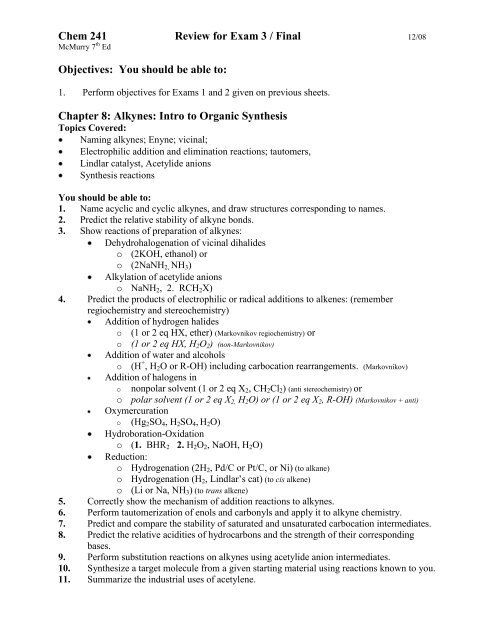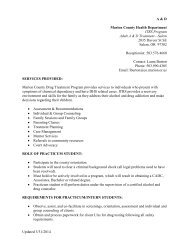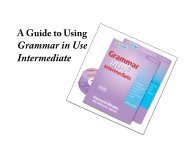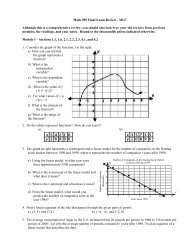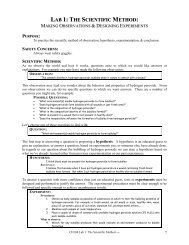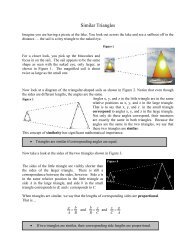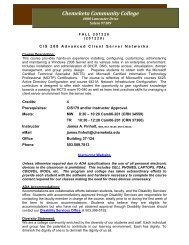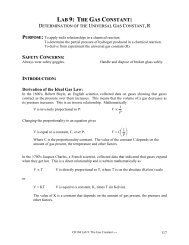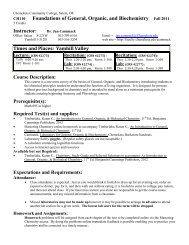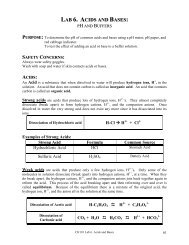Chem 241
Chem 241
Chem 241
You also want an ePaper? Increase the reach of your titles
YUMPU automatically turns print PDFs into web optimized ePapers that Google loves.
<strong>Chem</strong> <strong>241</strong> Review for Exam 3 / Final 12/08<br />
McMurry 7 th Ed<br />
Objectives: You should be able to:<br />
1. Perform objectives for Exams 1 and 2 given on previous sheets.<br />
Chapter 8: Alkynes: Intro to Organic Synthesis<br />
Topics Covered:<br />
Naming alkynes; Enyne; vicinal;<br />
Electrophilic addition and elimination reactions; tautomers,<br />
Lindlar catalyst, Acetylide anions<br />
Synthesis reactions<br />
You should be able to:<br />
1. Name acyclic and cyclic alkynes, and draw structures corresponding to names.<br />
2. Predict the relative stability of alkyne bonds.<br />
3. Show reactions of preparation of alkynes:<br />
Dehydrohalogenation of vicinal dihalides<br />
o (2KOH, ethanol) or<br />
o (2NaNH 2, NH 3 )<br />
Alkylation of acetylide anions<br />
o NaNH 2 , 2. RCH 2 X)<br />
4. Predict the products of electrophilic or radical additions to alkenes: (remember<br />
regiochemistry and stereochemistry)<br />
Addition of hydrogen halides<br />
o (1 or 2 eq HX, ether) (Markovnikov regiochemistry) or<br />
o (1 or 2 eq HX, H 2 O 2 ) (non-Markovnikov)<br />
Addition of water and alcohols<br />
o (H + , H 2 O or R-OH) including carbocation rearrangements. (Markovnikov)<br />
Addition of halogens in<br />
o nonpolar solvent (1 or 2 eq X 2 , CH 2 Cl 2 ) (anti stereochemistry) or<br />
o polar solvent (1 or 2 eq X 2, H 2 O) or (1 or 2 eq X 2 , R-OH) (Markovnikov + anti)<br />
Oxymercuration<br />
o (Hg 2 SO 4 , H 2 SO 4 , H 2 O)<br />
Hydroboration-Oxidation<br />
o (1. BHR 2 2. H 2 O 2 , NaOH, H 2 O)<br />
Reduction:<br />
o Hydrogenation (2H 2 , Pd/C or Pt/C, or Ni) (to alkane)<br />
o Hydrogenation (H 2 , Lindlar’s cat) (to cis alkene)<br />
o (Li or Na, NH 3 ) (to trans alkene)<br />
5. Correctly show the mechanism of addition reactions to alkynes.<br />
6. Perform tautomerization of enols and carbonyls and apply it to alkyne chemistry.<br />
7. Predict and compare the stability of saturated and unsaturated carbocation intermediates.<br />
8. Predict the relative acidities of hydrocarbons and the strength of their corresponding<br />
bases.<br />
9. Perform substitution reactions on alkynes using acetylide anion intermediates.<br />
10. Synthesize a target molecule from a given starting material using reactions known to you.<br />
11. Summarize the industrial uses of acetylene.
Chapter 9: Stereochemistry<br />
Topics Covered:<br />
Handedness: chiral, plane of symmetry, achiral, chiral center, plane-polarized light,<br />
Optical activity, devorotatory, dextrorotatory, specific rotation<br />
Stereoisomers: enantiomers, diastereomers, meso,<br />
Configuration, absolutie configuration, racemate, resolution<br />
Prochirality, re face, si face, prochiral center, pro-R, pro-S<br />
You should be able to:<br />
1. Distinguish between Constitutional isomers and Stereoisomers.<br />
2. Recognize stereogenic centers and identify them as R or S.<br />
3. Define and distinguish plane of symmetry, chirality, polarimeter, specific rotation.<br />
4. Compare and contrast the physical and chemical properties of enantiomers and<br />
diasteriomers.<br />
5. Locate the symmetry plane of a meso compound.<br />
6. Predict and draw the 'wedge-and-dash structures' and the Fisher projections of<br />
stereoisomers.<br />
7. Calculate the number of possible stereoisomers from the number of stereogenic centers.<br />
8. Distinguish between (+), (-), dextrorotatory, and levorotatory.<br />
9. Calculate the percent optical purity if given the enantiomeric excess.<br />
10. Distinguish between and identify specific erythro, threo, and meso isomers.<br />
11. Develop a plan for chemically resolving a racemic mixture.<br />
12. Distinguish between absolute and relative configuration.<br />
13. Distinguish between enantiotopic and diastereotopic hydrogens. Label as pro-R or pro-S.<br />
14. Distinguish between a regioselective, stereoselective, and a stereospecific reaction.<br />
15. Predict the stereochemistry of reaction products, using the concept of prochirality when<br />
appropriate.


